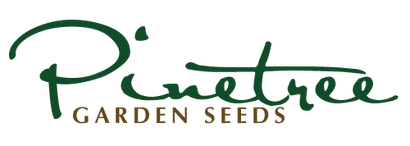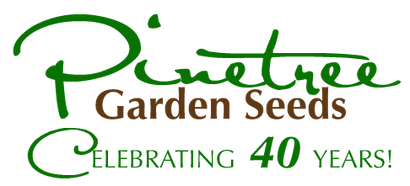Your Cart is Empty
- Vegetables
- Flowers
- Flowers A-C
- Flowers More C's
- Canary Creeper
- Candy Tuft
- Castor Bean
- Catmint (Nepeta)
- Celosia
- Centaurea (Bachelors Buttons)
- Chilean Glory Flower
- Chrysanthemum (Fall Mum)
- Cineraria (Dusty Miller)
- Clarkia
- Cleome
- Cobaea (Monastery Bells)
- Coleus
- Convolvulus
- Coreopsis
- Cosmos
- Cynoglossum (Chinese Forget-Me-Not)
- Cypress Climber and Vine
- Flowers D-H
- Dahlia
- Daisy
- Datura
- Delphinium
- Dianthus
- Dichondra
- Echinacea (Coneflower)
- Eupatorium (Joe Pye Weed)
- Fall Bulbs
- Forget Me Not
- Foxglove (Digitalis)
- Gaillardia (Blanket Flower)
- Gazania
- Geranium
- Gladiolus Bulbs
- Gomphrena (Globe Amaranth)
- Helenium (Helens's Flower)
- Heliopsis (False Sunflower)
- Hibiscus
- Hollyhock
- Hyacinth Bean
- Hypoestes (Polka Dot Plant)
- Flowers I-P
- Impatiens
- Irish Moss
- Flowering Cabbage & Kale
- Larkspur
- Lavatera (Mallow)
- Lobelia
- Lupine
- Malva
- Marigolds
- Mexican Hat Coneflower
- Mina Lobata
- Mirabilis
- Monarda (Bee Balm)
- Morning Glories
- Nasturtiums
- Nigella
- Nicotiana (Flowering Tobacco)
- Ornamental Grasses
- Ornamental Oregano
- Ornamental Pepper
- Papyrus (Umbrella plant)
- Pansies
- Pentas
- Petunias
- Peony
- Phacelia (California Blue Bells)
- Phlox
- Poppy
- Portulaca
- Flowers R-Z
- Rudbeckia (Black Eyed-Susan)
- Salpiglossis (Velvet Flower)
- Salvia
- Schizanthus (Poor Man's Orchid)
- Sedum
- Showy Goldeneye
- Snapdragons
- Stachys (Lamb's Ear)
- Statice
- Stocks
- Strawflower
- Sunflowers
- Sweet Annie
- Sweet Pea
- Talinum (Jewels Of Opar)
- Taraxacum (Pink Dandelion)
- Thunbergia (Black Eyed Susan Vine)
- Tithonia (Mexican Sunflower)
- Verbascum
- Verbena
- Vinca
- Viola
- Zinnia
- Flower Mixtures
- Herbs
- Fall Flower Bulbs
- Garlic
- Spring Plants
- Supplies
- Seed Starting Supplies
- Plant & Garden Labels
- Planting Mediums
- Greenhouses
- Season Extenders
- Containers & Hangers
- Composting Supplies
- Trellis & Plant supports
- Watering Aides
- Weather Monitors
- Soil Amendments & Fertilizers
- Cover Crops
- Landscape Fabric & Weed Control
- Pest Control
- Animal Deterents
- The Birds & The Bees
- Tools
- Kitchen Gear
- Canning
- Sale Gardening Supplies
- Sale Kitchen Gear
- Books
- Spices and Teas
- Ready To Grow Garden Kits!
- Clearance
- Canary Creeper
- Candy Tuft
- Castor Bean
- Catmint (Nepeta)
- Celosia
- Centaurea (Bachelors Buttons)
- Chilean Glory Flower
- Chrysanthemum (Fall Mum)
- Cineraria (Dusty Miller)
- Clarkia
- Cleome
- Cobaea (Monastery Bells)
- Coleus
- Convolvulus
- Coreopsis
- Cosmos
- Cynoglossum (Chinese Forget-Me-Not)
- Cypress Climber and Vine
- Dahlia
- Daisy
- Datura
- Delphinium
- Dianthus
- Dichondra
- Echinacea (Coneflower)
- Eupatorium (Joe Pye Weed)
- Fall Bulbs
- Forget Me Not
- Foxglove (Digitalis)
- Gaillardia (Blanket Flower)
- Gazania
- Geranium
- Gladiolus Bulbs
- Gomphrena (Globe Amaranth)
- Helenium (Helens's Flower)
- Heliopsis (False Sunflower)
- Hibiscus
- Hollyhock
- Hyacinth Bean
- Hypoestes (Polka Dot Plant)
- Impatiens
- Irish Moss
- Flowering Cabbage & Kale
- Larkspur
- Lavatera (Mallow)
- Lobelia
- Lupine
- Malva
- Marigolds
- Mexican Hat Coneflower
- Mina Lobata
- Mirabilis
- Monarda (Bee Balm)
- Morning Glories
- Nasturtiums
- Nigella
- Nicotiana (Flowering Tobacco)
- Ornamental Grasses
- Ornamental Oregano
- Ornamental Pepper
- Papyrus (Umbrella plant)
- Pansies
- Pentas
- Petunias
- Peony
- Phacelia (California Blue Bells)
- Phlox
- Poppy
- Portulaca
- Rudbeckia (Black Eyed-Susan)
- Salpiglossis (Velvet Flower)
- Salvia
- Schizanthus (Poor Man's Orchid)
- Sedum
- Showy Goldeneye
- Snapdragons
- Stachys (Lamb's Ear)
- Statice
- Stocks
- Strawflower
- Sunflowers
- Sweet Annie
- Sweet Pea
- Talinum (Jewels Of Opar)
- Taraxacum (Pink Dandelion)
- Thunbergia (Black Eyed Susan Vine)
- Tithonia (Mexican Sunflower)
- Verbascum
- Verbena
- Vinca
- Viola
- Zinnia
- Flower Mixtures








Catherine A Schaller
July 16, 2023
Lovely, down to earth (ha! pun intended!) article, explaining so much to folks who may not have knowledge of native vs non native, aggressive vs invasive. I became a certified Master Naturalist in my new home state (VA), and it is amazing how much I didn’t know about native plants. And once you do know, you can’t unsee it. We are surrounded by mostly Asian landscape plantings, many invasive, pushed on us by the big box stores, HOAs and landscapers. I am working hard to convert my small suburban yard to more natives. Rome wasn’t built in a day, but every bit counts! Thank you for your article.